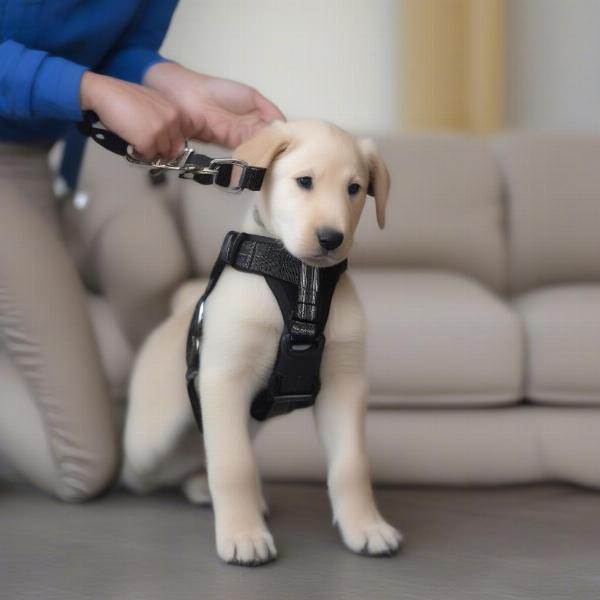Choosing between a dog harness and a collar for your puppy is a crucial decision. Both have their pros and cons, and the best choice depends on your puppy’s breed, size, temperament, and training goals. This article will explore the differences between harnesses and collars, helping you make an informed decision for your furry friend’s safety and comfort.
Harness vs. Collar: Understanding the Key Differences
A collar fits around your puppy’s neck, while a harness goes around their chest and back. This fundamental difference impacts how each affects your puppy’s body, especially during walks and training. Collars exert pressure on the neck, which can lead to potential tracheal damage in some breeds, especially smaller dogs or those prone to respiratory issues. Harnesses, on the other hand, distribute pressure more evenly across the body, reducing strain on the neck and making them a safer option for pulling puppies.
Choosing the Right Harness for Your Puppy
If you decide a harness is the best option for your puppy, selecting the right type is important. There are various types of harnesses available, each with its unique features and benefits. Front-clip harnesses are ideal for training as they discourage pulling by gently steering your puppy back towards you. Back-clip harnesses are suitable for casual walks and generally offer more comfort for relaxed walking. fancy dog harness can also be a good option for special occasions. Consider your puppy’s size, activity level, and training needs when choosing a harness.
Choosing the Right Collar for Your Puppy
While harnesses are often recommended for puppies, collars can still be a viable option in certain situations. If your puppy doesn’t pull excessively and is not of a breed prone to breathing problems, a properly fitted collar can be used for identification tags and leash attachment. Look for a lightweight, adjustable collar made of comfortable material. Avoid choke chains or prong collars, as these can be harmful to your puppy’s delicate neck. smallest dog training collar are specifically designed for small breeds.
When to Use a Harness or Collar for Training
Both harnesses and collars can be used for training, but each offers different advantages. Harnesses are generally preferred for pullers, as they provide more control and prevent injury. Collars, particularly martingale collars, can be helpful for training loose-leash walking for dogs who don’t pull excessively. Regardless of your choice, consistency and positive reinforcement are key to successful training.
Expert Insights
Dr. Emily Carter, a certified veterinary behaviorist, recommends, “For most puppies, a harness is the safer and more comfortable option, especially during training. It minimizes pressure on the trachea and allows for better control without causing discomfort.”
 Puppy training with harness and collar
Puppy training with harness and collar
Conclusion
Choosing between a dog harness or collar for your puppy depends on various factors. While harnesses generally provide better safety and control, especially for pullers and breeds susceptible to tracheal issues, collars can be suitable for puppies who walk calmly on a leash. truelove dog harness and dog collars and charms offer various options you can consider. Prioritize your puppy’s comfort and safety, and always consult with your veterinarian if you have any concerns.
FAQ
- Is a harness better than a collar for a puppy? Generally, harnesses are recommended for puppies, as they distribute pressure more evenly and reduce the risk of neck injuries.
- What type of harness is best for a puppy who pulls? A front-clip harness is a good option for puppies who pull, as it gently steers them back towards you.
- Can I use a collar for training my puppy? Yes, collars can be used for training, but avoid harsh corrections and prioritize positive reinforcement.
- When can my puppy start wearing a collar? Your puppy can start wearing a lightweight collar with identification tags as soon as they come home.
- What size collar should I get for my puppy? Measure your puppy’s neck and add a couple of inches for comfort. Ensure the collar is adjustable for growing puppies.
- How do I introduce my puppy to a harness or collar? Introduce the harness or collar gradually and associate it with positive experiences, such as treats and praise.
- What should I do if my puppy keeps trying to chew on their harness or collar? Distract your puppy with a chew toy and offer positive reinforcement when they leave the harness or collar alone.
ILM Dog is a leading online resource for dog owners worldwide. We offer expert advice on all aspects of dog care, from breed selection and puppy care to senior dog care and travel tips. We also offer a wide range of products and accessories to help you give your furry friend the best possible life. To learn more, contact us at [email protected] or call us at +44 20-3965-8624. ILM Dog is your one-stop shop for all things dog-related.